This article is based on a presentation given at SaaS Metrics Summit 2022. Catch the full talk OnDemand right here.
My name is Pablo Garcia Cano, and I'm a senior product marketing manager at Auctane. I'm thrilled to be here to share with you what I’ve learned about how to build and track the metrics that will bring the most value to your customers.
To tell you a little bit about me, I'm from Mexico City, I’ve worked in marketing CPG brands, and I had my first taste of software as a service in 2015 when I co-founded a company focused on building last-mile logistics solutions.
In 2016, I moved to the US to pursue a master's degree and transition fully into the technology sector. After that, I worked at Amazon for about two years, and for the past year and a half, I've been leading product marketing at Auctane.
For those who have never heard of Auctane, our products help eCommerce businesses of all sizes with their mailing, shipping, and logistics needs. We bring order management software to companies ranging from individuals that ship out of their garage to Fortune 500 companies shipping from multiple warehouses worldwide.
Before we dive in, here's a brief breakdown of our main talking points:
- Product marketing 'aha' moments
- How to identify your aha moment and get customers to reach it faster
- Case study
- To wrap up
Product marketing 'aha' moments
In case you’re new to product marketing, our function sits at the intersection of marketing, product, sales, and customer success. PMMs focus on who the product is for, the value the product provides for the customer, and helping customers get value from the product and achieve their jobs to be done.
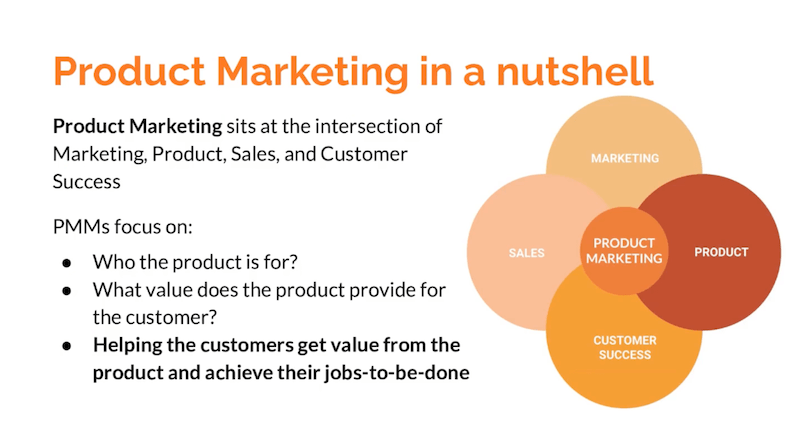
A common misconception is that product marketing is about marketing physical products. In reality, product marketing is a combination of tactics and activities that drive the success of any product or service. We define this success in terms of aha moments.
Regardless of where a customer is in their journey, as product marketers, we're always looking to create aha moments. We want to drive customer engagement and product adoption. We want to drive retention, we want to minimize churn, and we even want to bring in new revenue streams.
The beauty of aha moments is that they can be unique and subjective, and they may occur at different stages of the customer lifecycle.
Aha moments show how software can evoke an emotional reaction in its users, and they’re leading indicators of how a regular user becomes an engaged user and starts using your product constantly.
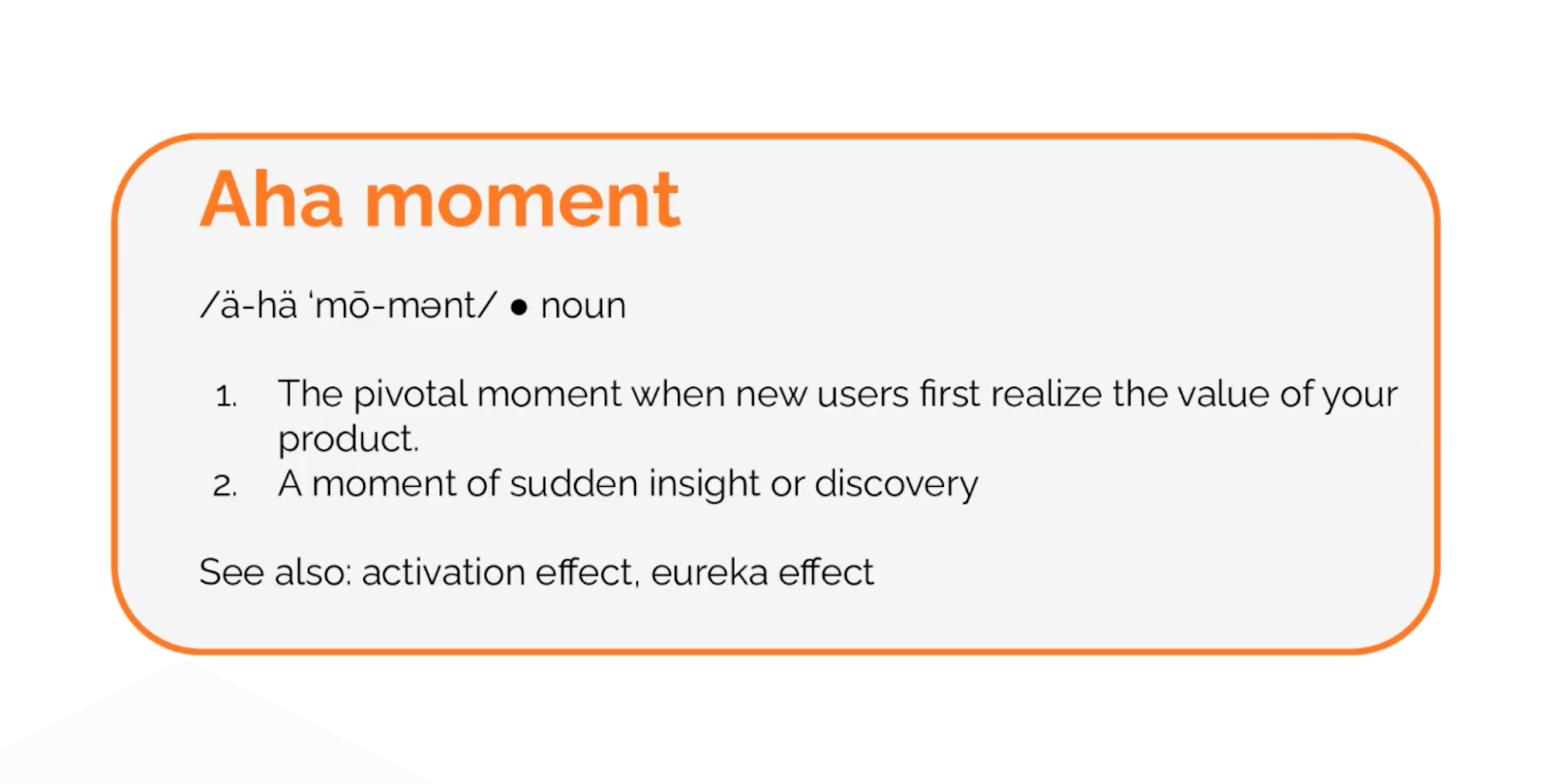
Now, you might think that using quantitative indicators to measure and track occurrences of aha moments contradicts the very nature of these moments.
However, quantitative indicators are the best-proven ways to utilize this concept and steer growth operations in the right direction. It's worth caring about the aha moment because of its impact on so many important metrics that affect the bottom line.
Let's look at some companies and how they've defined their aha moments. In the beginning, Facebook defined their users’ aha moment as connecting with seven friends within the first 10 days.
For Dropbox, it was about saving one file on one device. Twitter defined it as following 30 users and having one-third of them follow you back. For Slack, it was 2000 messages sent within a team or an organization.
I could go on listing different companies and how they define their aha moments, but instead, let’s think about what all of these examples have in common. Each of these milestones represents a moment when customers are experiencing firsthand the value these products offer.
A key thing to consider is that aha moments don't happen only once. They're a set of actions that separate customers who find value in your product from those who don't.
Customers who find value will come back, and if you identify which actions separate retained power users from the ones that churn, you’ll know what drives customer value, and you’ll have found your product’s aha moment.
How to identify your aha moment and get customers to reach it faster
Whichever company you work for, you probably know your product’s value so well that you can recite it by heart. But can you recognize your product's value from the user's perspective? That's key. Let’s look at the four steps you can take to identify that aha moment and get your customers there faster.
#1: Talk to your power users
The first one is a no-brainer. You need to go out and talk to the customers who use your product constantly and have been doing so for a while. It’s super important to ask them very simple questions. Here are a few examples to get you started:
- How do you use our product?
- Are there features you use all the time?
- Are there any features you never use?
- What do you love the most about our product?
- What made you decide you wanted to pay for the product?
It's important to look at their answers closely because they will help you reveal what a successful user experience with your product looks like, bringing you closer to identifying that aha moment.
#2: Talk to your churned users
Now the next step is to talk with your churned users. The goal here is to understand why they didn’t stick with you. Usually, it's because they didn’t receive the value they expected from your product. Here are a few questions you might ask:
- What outcome were you hoping to get out of the product?
- Were you able to experience that outcome in the product?
- Why was our product not the right solution?
- What could we have done differently to keep you around?
There's a wide array of answers you can get from churned users. Some might still be evaluating whether or not to convert.
Sometimes your product is not a fit. Sometimes you’ll learn that your product is too complex, or maybe it’s too expensive. Sometimes you could be missing a product feature or key integration. And sometimes they’ve just gone with another solution or competitor.
#3: Dive deep into data
I can't stress the importance of this enough. You need to dive deep into your data, identify the patterns, and look at your customers’ value metrics. The goal of a free trial is not simply to engage new users; it’s to help new users to consistently get value from your product so they ultimately start paying for it.
To make this data dive deep easier, I suggest writing down what someone has to do to get value from your product. Next, create a short list of all your value metrics and then another list of all the features within your product.
You need to consider the behaviors of both your best customers and your churned customers. Doing this will help you identify successful user journeys. There's a five-step process to follow.
- Make a list of your most successful customers and analyze what features they used early on, which features they continued to use, and which ones they stopped using.
- Identify the behaviors that best correlate with continuing to use your product for an extended period of time.
- Answer these questions about your most successful users:
- How does this data differ from what customers said in interviews?
- Are my onboarding steps aligned with what power users do with my product?
- Is there only one path to becoming a power user, or are there several?
4. Answer these questions about your churned users:
- What did they try to do?
- Where did they get stuck?
- What features did they try?
5. Identify moments of friction in your churned users’ journeys. Perhaps a certain feature didn’t work. Maybe there was a time lag, and it took too long to complete what should have been a very simple task. It’s usually these moments of friction that separate retained users from churned users.
#4: Experiment
At this point, you should have a pretty good idea of the actions users can take in your product that help them realize its value, as well as the moments of friction that cause your users to churn. Now it’s time to create a shortlist of actions and behaviors to test so you can validate your hypotheses.
It's important to create an experiment log. This is a great way to track your experiments and their results and hone in on the metrics you want to improve. You should also prioritize experiments based on the metric or objective you want to track.
As tempting as it can be to test all your hypotheses at once, I’d recommend that you only run one experiment at a time. Doing too many experiments at once will leave you guessing about what’s moving the needle for your organization.
There are so many possibilities for your experiments. You might want to test the effect of using a specific set of features or having new users use the product several times within the first week. Maybe you want to try showing users an onboarding video before they dive into the product. That's up to you.
It’s also up to you to find and minimize friction points so customers can get the maximum value out of your product. Analyzing how your product is used is vital in discerning your aha moment.
It will help you understand what people are doing with the product, how they engage with it, and hopefully what value they get from the product that makes them want to keep using it.
Case study
I’d like to run through the aha moment framework with a case study from an Auctane brand called ShipStation. I'll start by telling you a little bit about what ShipStation does and the value proposition that we saw in ShipStation as product managers.
ShipStation is a SaaS shipping platform that allows eCommerce merchants to manage all their small parcel and LTL shipping needs in one place. It also offers customer experience tools such as branded tracking pages and branded returns, among other value-added services.
ECommerce merchants might be selling their products on multiple platforms and using several shipping carriers. ShipStation works like a hub, allowing merchants to manage all their orders from every platform and carrier in one place.
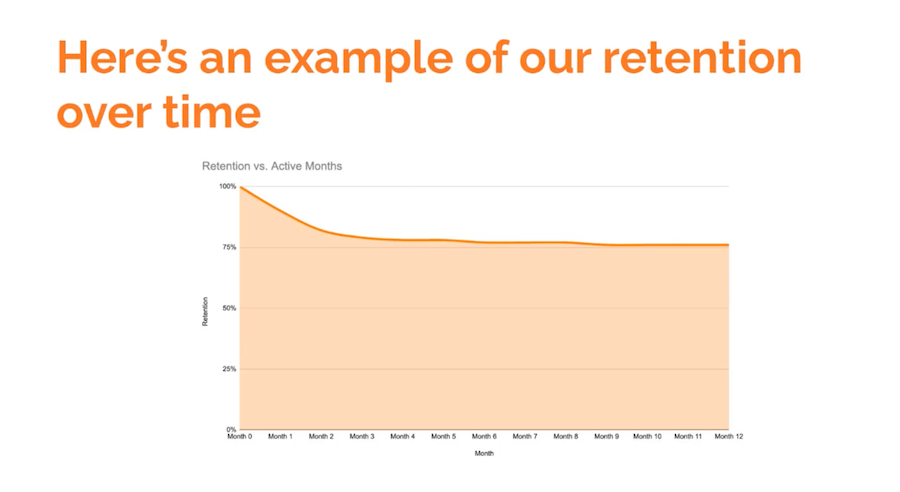
A lot of our customers were getting value from our product, but a larger proportion than we would like were churning.
We looked at the customers who had graduated from a free trial and what their retention looked like months after they converted to paid users. We soon learned that if a merchant uses ShipStation for over three months, they will most likely stick with us for the long term.
We set out to solve for the 20-something percent of merchants who were leaving too soon. We wanted to know why, despite the free trial, these customers weren’t experiencing the value that ShipStation had to offer. Our goal was to solve this and get them to stay.
Our value proposition
We understood our value proposition, but what was less clear was exactly how and when ShipStation positively impacts eCommerce merchants' experience. We decided to take a step back and look at the value chain from our customers' perspective. Let's run through it real quick.
First, merchants create listings for their products on their eCommerce store or marketplace, and then customers see the products and place an order. Merchants then receive the order, process it, and pick and pack it from their warehouse.
They then weigh the package, print and attach a shipping label, and ship it with their preferred carrier. Merchants then share the tracking data and ETA with their customers. Lastly, customers receive their orders and are delighted.
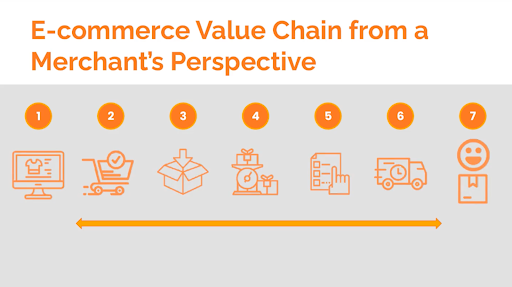
Looking at this value chain, we wanted to see where ShipStation comes in and provides value for eCommerce merchants. There are several points where this happens. At checkout, we offer merchants the ability to display real-time shipping costs to their customers.
We’re the go-to software to help them run their warehouse. We also allow merchants to build branded tracking pages to share with their customers and drive traffic back into their stores.
We took a step back and asked ourselves what merchants want from our product. They want to save time processing orders in their warehouse. They want to save money on shipping labels using pre-negotiated rates. And lastly, they want to drive engagement with their customers, drive traffic back to their stores, and sell more products.
Our aha moment analysis
Next, we followed the aha moment identification framework. First, we spoke with power users to learn what they love the most about our product, what features they use, and how they identify the value within our product.
Then we spoke with our churned users, trying to understand why they left and what we could have done differently.
Then we dove into the data. And this is the most important part: we analyzed every action down to the most minute detail.
We performed a time-based analysis, tracking merchant behaviors over those crucial 90 days that determine whether they'll stick with us for the long term or leave. We were looking to learn when power users adopted certain features and how that differed from those users that churn.
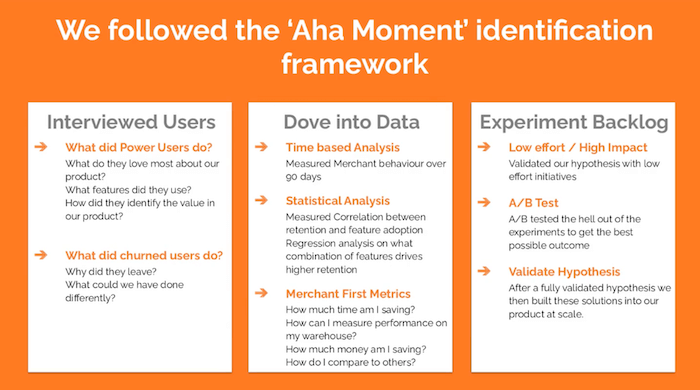
We followed that with statistical analysis measuring the correlation between retention and adoption of different features. We then did a regression analysis to uncover what combination of features drives higher retention, looking to create a recipe for retention based on our different user personas.
Then we created merchant-focused metrics to answer the following questions for our users:
- How much time am I saving?
- How can I measure the performance of my warehouse?
- How much money am I saving by shipping with you or using your software?
- How do I compare with my competitors?
Lastly, we created an experiment backlog, focusing on moving fast with low-effort high-impact experiments. We A/B tested the hell out of the experiments to get the best possible outcomes. Finally, as we validated our hypothesis, we set out to build the solutions into our product at scale.
The experimental phase
Let's look at some of these low-effort experiments. We started trying out different email templates with merchants, using and testing different merchant-focused metrics, for example, the time taken to print the label because eBay measures performance based on this metric.
We also looked at the time it takes to ship a label because Shopify measures performance based on this. Then we tried out time to deliver – that's how Amazon measures performance.
We also wanted to check money saved on shipments; that's super relevant to our sellers and was a key metric that we followed.
We benchmarked merchants’ performance versus best practices, what the experts are doing, and how long it takes an expert to do a specific action.
We also compared our users to merchants like them, merchants of their size who ship a similar number of orders in a similar category from the same number of warehouses.
We showed our users how to adopt different features that would improve their operations. We wanted to empower our merchants to accomplish their most important value metrics: saving money and saving time.
We tried out a bunch of different CTAs and landing pages answering questions like “How do I ship faster?” “How do I ship more cheaply?” “What integration should I use?” and “How do I engage better with my customers?”
We aim to be the expert on eCommerce and empower sellers to focus on what they do best, which is growing their business and creating new products while leaving all the cumbersome logistics and shipping to us.
We also iterated on designs countless times. We zoomed in on actions that caused our click-through rate to spike and drove higher feature adoption.
On top of all that, we created YouTube tutorials and engaged with merchants in forums and our own community portal. Whichever way an eCommerce merchant wants to learn, we cater to that. The objective is to push our customers to experience an aha moment as fast as possible.
To wrap up
Using this aha moment framework, we've identified our recipe for retention for different user personas, and I'm happy to say that we're setting an aggressive but very achievable goal based on data-driven insights to reduce our churn rate in those first 90 days.
Now it’s time for you to ask yourself, when do customers have an aha moment when using your product?

